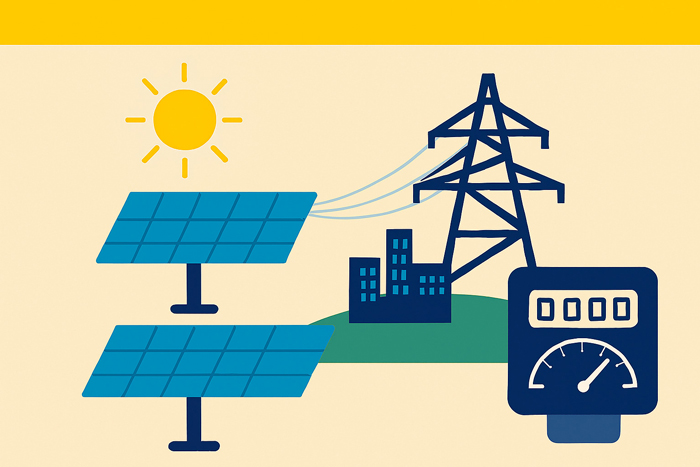State-level infrastructure mandates and clean energy projects drive revenue and operational momentum across Tata Power’s business verticals.
Tata Power, India’s largest vertically integrated power company, reported a consolidated profit after tax (PAT) of ₹12.62 billion for Q1 FY2026, marking a 6 per cent year-on-year increase. The company’s revenue rose to ₹174.64 billion, up 4 per cent from the previous year, while EBITDA grew by 17 per cent to ₹39.3 billion.
Praveer Sinha, CEO & Managing Director, stated, “We have commenced FY2026 on a high note, with strong performance across all our business verticals. Our renewable energy portfolio continues to exceed expectations, as we drive innovation, scale, and efficiency across the clean energy value chain.”
He added that the company’s generation and transmission & distribution (T&D) businesses are delivering impressive gains. Tata Power’s distribution companies now serve approximately 13 million customers nationwide. Its Odisha Discoms have emerged as a national model for reform, and the company has applied for a distribution licence expansion in Maharashtra, targeting several key growth regions. The company’s total generation portfolio has now crossed 26 GW, including projects under development, with over 65 per cent sourced from clean energy.
Renewables Surge
In the renewables segment, Tata Power commissioned 652 MW of projects in Q1, which included 94 MW from its portfolio and 560 MW from third-party engineering, procurement, and construction (EPC) contracts. Its operational utility-scale capacity stands at 5.6 GW, comprising 4.6 GW of solar and 1 GW of wind. Plans are in place to add 1.6 GW during the remaining quarters of FY26.
The company achieved a record rooftop solar installation of 270 MWp in Q1 FY2026, pushing total installations above 200,000 units and cumulative rooftop solar capacity beyond 3.4 GWp. In addition, it sold 107 MW of modules and 54 MW of cells to third-party customers during the quarter, generating an order value of ₹13.03 billion.
Tata Power joined forces with Tata Motors to develop a 131 MW wind-solar hybrid project, powering manufacturing units in Maharashtra and Gujarat. The project is expected to generate approximately 300 million units annually and offset more than 200,000 tonnes of carbon dioxide emissions.
The company secured a Letter of Award (LOA) from SJVN for an 88 MW round-the-clock renewable energy project under the Firm and Despachable Renewable Energy (FDRE)-3 scheme. This initiative is projected to supply 580 million units of clean energy annually, offsetting nearly 490,000 tonnes of carbon dioxide emissions. In a separate agreement, Tata Power signed a 200 MW FDRE Power Purchase Agreement (PPA) with NTPC, set to supply 1.3 billion units annually and offset up to 1 million tonnes of carbon dioxide emissions.
To meet group captive demands, the company signed a power delivery agreement (PDA) with Fiat India Automobiles for a 12.62 MWp renewable energy project in Akola, Maharashtra, expected to generate approximately 20.63 million units annually. A similar PDA was signed with Tata Realty and Infrastructure for a 6 MW project supporting current operations and future infrastructure development.
The rooftop solar campaign ‘Ghar Ghar Solar’ was launched in Bhubaneswar and Jaipur, and is now operational across six states. Tata Power also introduced two innovative lifestyle-focused rooftop solar solutions called MySine and Solaroof Design Spaces.
Powering On
In transmission and distribution, Tata Power Mumbai Transmission received approval from the Maharashtra Electricity Regulatory Commission (MERC) for development schemes worth ₹18 billion. It commissioned a 22kV Gas Insulated Substation (GIS) at Vikhroli and installed a 125 MVAR reactor at Trombay to support grid resilience and capacity.
The company is currently advancing six transmission projects, which together total more than 2,400 circuit kilometres. By 2027, its operational network is expected to expand beyond 7,000 circuit kilometres. It has applied to extend its electricity distribution licence in Maharashtra, targeting high-potential markets including Thane, Navi Mumbai, Panvel, Pune, Nashik, and Chhatrapati Sambhaji Nagar.
In Q1 FY2026, Tata Power reached a significant milestone by installing nearly 3 million smart meters across India. Its Delhi-based subsidiary Tata Power-DDL, in collaboration with Nissin Electric Co. Ltd, commissioned India’s first Micro Substation featuring a Power Voltage Transformer (PVT) at the RG22 Grid.
The company’s trading arm, Tata Power Trading Company Ltd. (TPTCL), launched a cooling-as-a-service (CaaS) business, which now features a pipeline of more than 200,000 tonnes of refrigeration capacity. During the quarter, 25 new HVAC optimisation projects worth ₹56 million were added to its portfolio.
Other developments included the commencement of construction at a 1,000 MW pumped hydro storage facility in Bhivpuri, Maharashtra.


